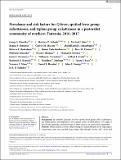| dc.description.abstract | Background: In northern Tanzania, Q fever, spotted fever group (SFG) rickettsioses,
and typhus group (TG) rickettsioses are common causes of febrile illness. We sought to
describe the prevalence and risk factors for these zoonoses in a pastoralist community.
Methods: Febrile patients ≥2 years old presenting to Endulen Hospital in the Ngorongoro
Conservation Area were enrolled from August 2016 through October 2017. Acute andconvalescent blood samples were collected, and a questionnaire was administered. Sera
were tested by immunofluorescent antibody (IFA) IgG assays using Coxiella burnetii
(Phase II), Rickettsia africae, and Rickettsia typhi antigens. Serologic evidence of exposure
was defined by an IFA titre ≥1:64; probable cases by an acute IFA titre ≥1:128; and
confirmed cases by a ≥4-fold rise in titre between samples. Risk factors for exposure and
acute case status were evaluated.
Results: Of 228 participants, 99 (43.4%) were male and the median (interquartile range)
age was 27 (16–41) years. Among these, 117 (51.3%) had C. burnetii exposure, 74 (32.5%)
had probable Q fever, 176 (77.2%) had SFG Rickettsia exposure, 134 (58.8%) had probable
SFG rickettsioses, 11 (4.8%) had TG Rickettsia exposure, and 4 (1.8%) had probable TG
rickettsioses. Of 146 participants with paired sera, 1 (0.5%) had confirmed Q fever,
8 (5.5%) had confirmed SFG rickettsioses, and none had confirmed TG rickettsioses.
Livestock slaughter was associated with acute Q fever (adjusted odds ratio [OR] 2.54, 95%
confidence interval [CI] 1.38–4.76) and sheep slaughter with SFG rickettsioses case
(OR 4.63, 95% CI 1.08–23.50).
Discussion: Acute Q fever and SFG rickettsioses were detected in participants with
febrile illness. Exposures to C. burnetii and to SFG Rickettsia were highly prevalent, and
interactions with livestock were associated with increased odds of illness with both path-
ogens. Further characterisation of the burden and risks for these diseases is warranted. | en_US |


